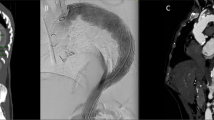Abstract
The frozen elephant trunk (FET) technique is useful in the single-stage treatment of aortic arch aneurysms. Since there is no established implantation method for evaluating the distal end of the FET during surgery, we propose the FET positioning method using the ostium of the coronary artery on transesophageal echocardiography (TEE) as an index. We performed 11 total arch replacement operations using an FET for aortic arch aneurysm. The planned position of the FET was determined by computed tomography (CT), and the distance to the ostium of the coronary artery was measured. Intraoperatively, using TEE as a guide, the FET was implanted using our method. Postoperative CT was evaluated the distance from the planned FET position, and the average and median difference was only 0.96 cm and 0.6 cm, respectively. TEE-guided FET deployment using the coronary artery ostium as an index is a simple and reproducible technique.


Similar content being viewed by others
References
Kato M, Ohnishi K, Kaneko M, Ueda T, Kishi D, Mizushima T, et al. New graft-implanting method for thoracic aortic aneurysm or dissection with a stented graft. Circulation. 1996;94:188–93.
Katayama K, Uchida N, Katayama A, Takahashi S, Takasaki T, Kurosaki T, et al. Multiple factors predict the risk of spinal cord injury after the frozen elephant trunk technique for extended thoracic aortic disease. Eur J Cardio-thorac Surg. 2015;47(4):616–20.
Flores J, Kunihara T, Shiiya N, Yoshimoto K, Matsuzaki K, Yasuda K. Extensive deployment of the stented elephant trunk is associated with an increased risk of spinal cord injury. J Thorac Cardiovasc Surg. 2006;131(2):336–42.
Uchida N, Katayama A, Higashiue S, Shiono M, Hata M, Minami K, et al. A new device as an open stent graft for extended aortic repair: a multicentre early experience in Japan. Eur J Cardio-thorac Surg. 2016;49(4):1270–8.
Ikeda A, Konishi T, Matsuzaki K, Jikuya T. Radiopaque ruler-guided frozen elephant trunk technique. Ann Vasc Dis. 2016;9(4):352–5.
Yamanaka K, Ishii H. Three-step method for transesophageal echocardiography-guided implantation of the frozen elephant trunk: how to prevent spinal cord injury. Gen Thorac Cardiovasc Surg. 2019;67(3):340–3.
Tanaka H, Minatoya K, Matsuda H, Sasaki H, Iba Y, Oda T, et al. Embolism is emerging as a major cause of spinal cord injury after descending and thoracoabdominal aortic repair with a contemporary approach: magnetic resonance findings of spinal cord injury. Interact Cardiovasc Thorac Surg. 2014;19(2):205–10.
Author information
Authors and Affiliations
Corresponding author
Ethics declarations
Conflict of interest
The authors declare no conflicts of interest in association with the present study.
Additional information
Publisher's Note
Springer Nature remains neutral with regard to jurisdictional claims in published maps and institutional affiliations.
Rights and permissions
About this article
Cite this article
Nogami, E., Furukawa, K., Fumoto, H. et al. Novel technique in frozen elephant trunk positioning method using the ostium of the coronary artery on transesophageal echocardiography as an index. Gen Thorac Cardiovasc Surg 70, 993–996 (2022). https://doi.org/10.1007/s11748-022-01847-x
Received:
Accepted:
Published:
Issue Date:
DOI: https://doi.org/10.1007/s11748-022-01847-x




